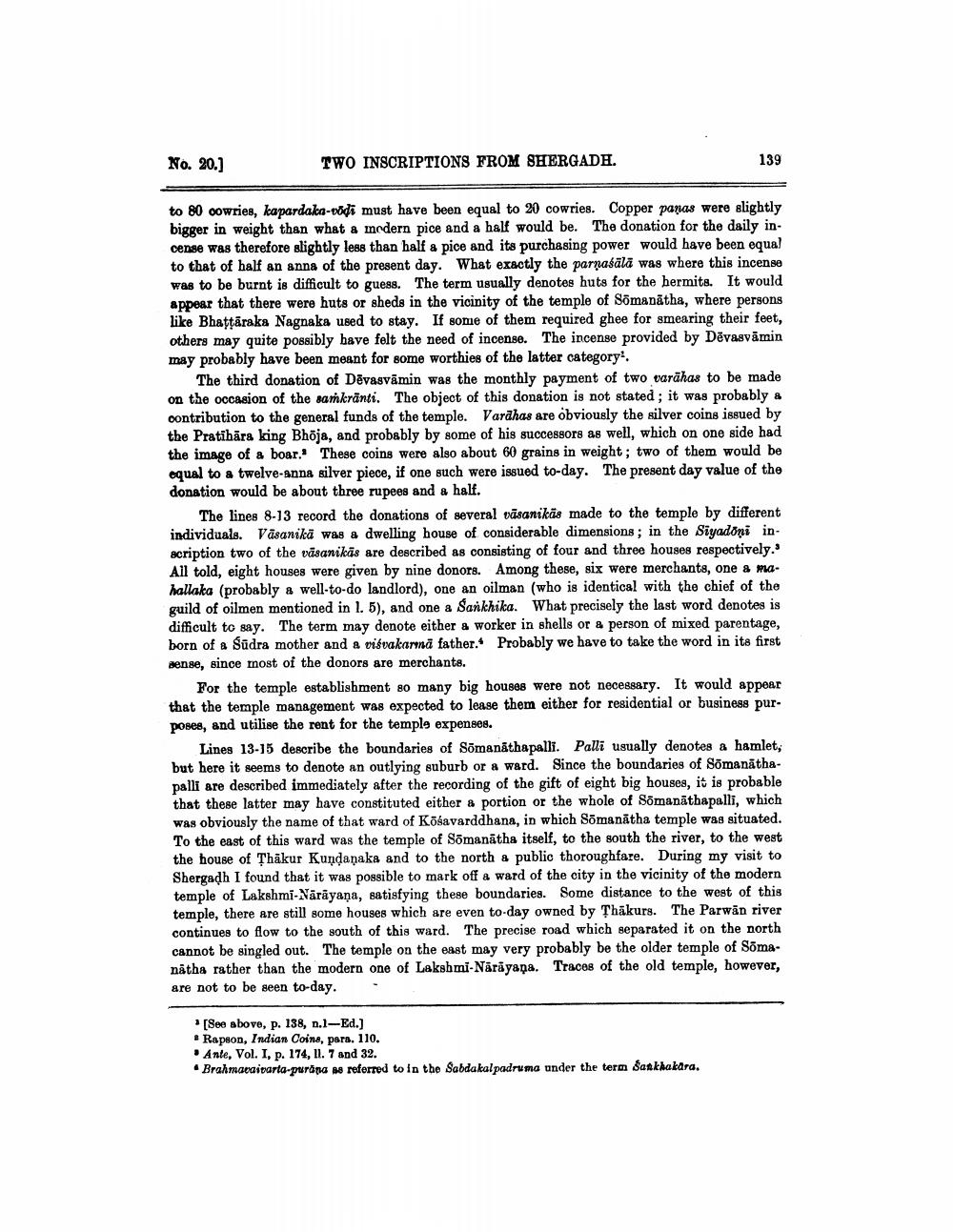________________
TWO INSCRIPTIONS FROM SHERGADH.
No. 20.]
to 80 cowries, kapardaka-vodi must have been equal to 20 cowries. Copper panas were slightly bigger in weight than what a modern pice and a half would be. The donation for the daily incense was therefore slightly less than half a pice and its purchasing power would have been equal to that of half an anna of the present day. What exactly the parnasala was where this incense was to be burnt is difficult to guess. The term usually denotes huts for the hermits. It would appear that there were huts or sheds in the vicinity of the temple of Somanätha, where persons like Bhaṭṭāraka Nagnaka used to stay. If some of them required ghee for smearing their feet, others may quite possibly have felt the need of incense. The incense provided by Devasvāmin may probably have been meant for some worthies of the latter category.
139
The third donation of Devasvamin was the monthly payment of two varahas to be made on the occasion of the samkranti. The object of this donation is not stated; it was probably a contribution to the general funds of the temple. Vardhas are obviously the silver coins issued by the Pratihāra king Bhoja, and probably by some of his successors as well, which on one side had the image of a boar. These coins were also about 60 grains in weight; two of them would be equal to a twelve-anna silver piece, if one such were issued to-day. The present day value of the donation would be about three rupees and a half.
The lines 8-13 record the donations of several väsanikäs made to the temple by different individuals. Vasanika was a dwelling house of considerable dimensions; in the Siyadoni inscription two of the vasanikäs are described as consisting of four and three houses respectively." All told, eight houses were given by nine donors. Among these, six were merchants, one a mahallaka (probably a well-to-do landlord), one an oilman (who is identical with the chief of the guild of oilmen mentioned in 1. 5), and one a Sankhika. What precisely the last word denotes is difficult to say. The term may denote either a worker in shells or a person of mixed parentage, born of a Sūdra mother and a viśvakarma father. Probably we have to take the word in its first sense, since most of the donors are merchants.
For the temple establishment so many big houses were not necessary. It would appear that the temple management was expected to lease them either for residential or business purposes, and utilise the rent for the temple expenses.
Lines 13-15 describe the boundaries of Somanathapalli. Palli usually denotes a hamlet, but here it seems to denote an outlying suburb or a ward. Since the boundaries of Somanāthapalli are described immediately after the recording of the gift of eight big houses, it is probable that these latter may have constituted either a portion or the whole of Somanathapalli, which was obviously the name of that ward of Kösavarddhana, in which Sōmanatha temple was situated. To the east of this ward was the temple of Sōmanatha itself, to the south the river, to the west the house of Thakur Kundanaka and to the north a public thoroughfare. During my visit to Shergadh I found that it was possible to mark off a ward of the city in the vicinity of the modern temple of Lakshmi-Nārāyaṇa, satisfying these boundaries. Some distance to the west of this temple, there are still some houses which are even to-day owned by Thakurs. The Parwan river continues to flow to the south of this ward. The precise road which separated it on the north cannot be singled out. The temple on the east may very probably be the older temple of Somanatha rather than the modern one of Lakshmi-Narayana. Traces of the old temple, however, are not to be seen to-day.
[See above, p. 138, n.1-Ed.]
Rapson, Indian Coins, para. 110. Ante, Vol. I, p. 174, 11. 7 and 32.
Brahmavaivarta-purana as referred to in the Sabdakalpadruma under the term Sankhakara.




